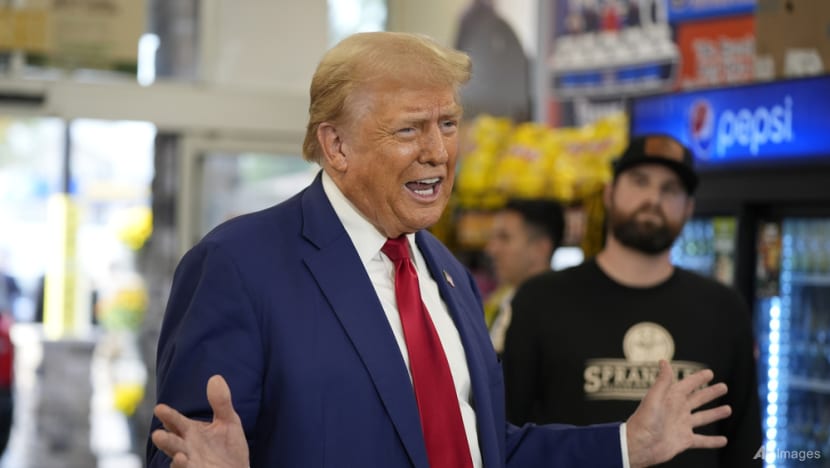Commentary: Trump fanned inflation fears. Now they haunt his presidency
Consumer expectations about price increases can be self-fulfilling, says Jonathan Levin for Bloomberg Opinion.

MIAMI, Florida: Inflation concerns may very well have delivered Donald Trump to the presidency. During the campaign, he routinely harped on the elevated cost of eggs and bacon and argued that his predecessor Joe Biden – together with Federal Reserve Chair Jerome Powell – had enabled an “inflation nightmare”.
Now, he faces public inflation expectations that are utterly divorced from reality and could well stand in the way of his success as president.
The latest University of Michigan survey showed that consumers expect costs to rise 4.3 per cent over the next year, the worst inflation expectations since 2023. More disconcertingly, they expect prices to rise 3.3 per cent annually over the next five to 10 years, the highest level for the longer-term gauge since 2008.
Mainstream economists are far more optimistic, but the perception of an ongoing inflation crisis could well be self-fulfilling.
That’s because there’s broad agreement among economists that inflation expectations are an important determinant of the path of realised inflation. The anticipation of higher costs can influence business’ pricing decisions; induce consumers to buy now to front-run future price hikes; and prompt workers to demand wage increases.
Expectations feature prominently in inflation forecast models, and are consulted by monetary policy practitioners at the world’s most powerful central banks. In mid-2022, Powell even cited rising consumer inflation expectations as justification for delivering the biggest single policy-rate increase since 1994.
TRICKY TO INTERPRET INFLATION EXPECTATIONS
But as much as economists agree on the importance of expectations, they disagree on the best way to measure them. Survey microdata reveals massive gaps in the public’s understanding of what inflation even is.
Evidence also suggests that Americans’ answers to inflation-expectation surveys tend to overweight variables such as gasoline and food prices, in part because they buy them frequently enough to notice the difference. Though important, central banks often downplay food and energy in their views about future inflation since they’re inherently volatile.
The hyper-partisan political environment coupled with the post-truth world of social media have made inflation expectations even trickier to interpret.
One Federal Reserve Bank of Cleveland working paper, authored with Morning Consult economist John Leer and outside academics, overlaid Facebook data and inflation expectations and found that social networks now play a prominent role in shaping expectations.
In contrast to the traditional media of old, narratives can now move at lightning speed, and the particulars of the story can vary widely across social media silos.
Indeed, the latest Michigan survey showed that it’s Democrats that are now driving the inflation expectations indexes higher – a sharp break from the past several years. In the next year, Democrats expect prices to rise around 5.1 per cent, presumably because of concerns about the effect of Trump’s proposed tariffs. Republicans’ expectations have collapsed to the point where they now imply essentially zero inflation.
Even accounting for Trump’s policy priorities, no mainstream economist surveyed by Bloomberg thinks that real inflation in 2025 will be anywhere near as high as Democrats fear or as low as Republicans anticipate. It’s hard to justify the disparity, since most inflation indexes – of both headline inflation and core, excluding food and energy – paint a consistent picture of inflation that is just slightly above normal.
INFLATION HAS BEEN POLITICISED
Trump and his fellow Republicans bear a lot of responsibility for the manner in which inflation was first politicised. They discounted the global nature of the post-pandemic price surge that reflected, at least in part, supply chain disruptions.
Trump even took pot shots at the credibility of America’s central bank. But in a world of hyper-partisan politics and social media, it looks as though unanchored inflation expectations have become a bipartisan problem that could have serious consequences.
One caveat to all of this: The University of Michigan survey provides just one imperfect read of consumer inflation expectations. Another index created by Morning Consult and the Cleveland Fed attempts to find a way around widespread concerns about such surveys including the gaps in Americans’ understanding about what inflation is and how it’s measured.
As an alternative, the Morning Consult-Cleveland Fed measure asks respondents how their incomes would have to change to make them “equally well-off”, given expectations about prices in the next 12 months. That index suggests that expectations have largely been moving sideways. It also finds that the gap between Republicans and Democrats has been closing.
Still, politicians and monetary policymakers need to be careful with inflation psychology. For Trump, that’s another reasons to shelve his tariff war and, equally critically, save the exaggerated language for other topics. His critics should also choose their words carefully. Finally, for the Fed, it’s probably one more reason to keep policy rates where they are for the time being.















